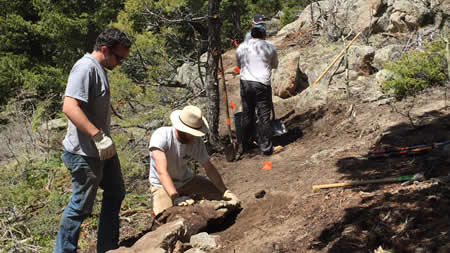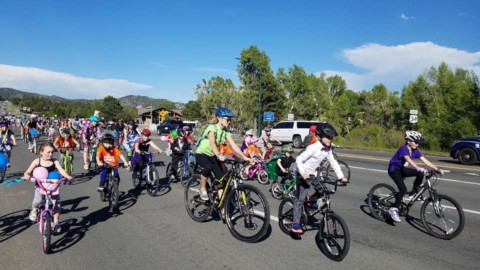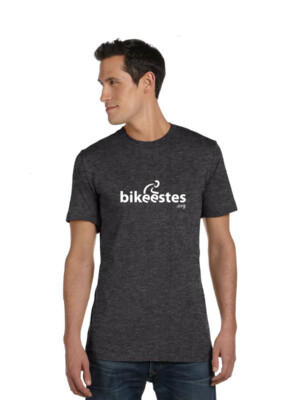Taken from http://thecyclist-lawyer.com (as of June 2019)
Click on the tab to read more
Ignorance of the law is no excuse… Do you know the laws in the areas you ride? Where you work, where you live, where you commute?
If not, take a moment to familiarize yourself with the following state and local/municipal laws and codes in common and popular cycling areas in the Denver-Boulder areas.
Colorado State Statutes applicable to cycling:
CRS §42-4-1412: Operation of bicycles and other human-powered vehicles
(1) Every person riding a bicycle or electrical assisted bicycle shall have all of the rights and duties applicable to the driver of any other vehicle under this article, except as to special regulations in this article and except as to those provisions which by their nature can have no application. Said riders shall comply with the rules set forth in this section and section 42-4-221, and, when using streets and highways within incorporated cities and towns, shall be subject to local ordinances regulating the operation of bicycles and electrical assisted bicycles as provided in section 42-4-111.
…
(3) No bicycle or electrical assisted bicycle shall be used to carry more persons at one time than the number for which it is designed or equipped.
(4) No person riding upon any bicycle or electrical assisted bicycle shall attach the same or himself or herself to any motor vehicle upon a roadway.
(5)(a) Any person operating a bicycle or an electrical assisted bicycle upon a roadway at less than the normal speed of traffic shall ride in the right-hand lane, subject to the following conditions:
(I) If the right-hand lane then available for traffic is wide enough to be safely shared with overtaking vehicles, a bicyclist shall ride far enough to the right as judged safe by the bicyclist to facilitate the movement of such overtaking vehicles unless other conditions make it unsafe to do so.
(II) A bicyclist may use a lane other than the right-hand lane when:
(A) Preparing for a left turn at an intersection or into a private roadway or driveway;
(B) Overtaking a slower vehicle; or
(C) Taking reasonably necessary precautions to avoid hazards or road conditions.
(III) Upon approaching an intersection where right turns are permitted and there is a dedicated right-turn lane, a bicyclist may ride on the left-hand portion of the dedicated right-turn lane even if the bicyclist does not intend to turn right.
(b) A bicyclist shall not be expected or required to:
(I) Ride over or through hazards at the edge of a roadway, including but not limited to fixed or moving objects, parked or moving vehicles, bicycles, pedestrians, animals, surface hazards, or narrow lanes; or
(II) Ride without a reasonable safety margin on the right-hand side of the roadway.
(c) A person operating a bicycle or an electrical assisted bicycle upon a one-way roadway with two or more marked traffic lanes may ride as near to the left-hand curb or edge of such roadway as judged safe by the bicyclist, subject to the following conditions:
(I) If the left-hand lane then available for traffic is wide enough to be safely shared with overtaking vehicles, a bicyclist shall ride far enough to the left as judged safe by the bicyclist to facilitate the movement of such overtaking vehicles unless other conditions make it unsafe to do so.
(II) A bicyclist shall not be expected or required to:
(A) Ride over or through hazards at the edge of a roadway, including but not limited to fixed or moving objects, parked or moving vehicles, bicycles, pedestrians, animals, surface hazards, or narrow lanes; or
(B) Ride without a reasonable safety margin on the left-hand side of the roadway.
(6)(a) Persons riding bicycles or electrical assisted bicycles upon a roadway shall not ride more than two abreast except on paths or parts of roadways set aside for the exclusive use of bicycles.
(b) Persons riding bicycles or electrical assisted bicycles two abreast shall not impede the normal and reasonable movement of traffic and, on a laned roadway, shall ride within a single lane.
(7) A person operating a bicycle or electrical assisted bicycle shall keep at least one hand on the handlebars at all times.
(8)(a) A person riding a bicycle or electrical assisted bicycle intending to turn left shall follow a course described in sections 42-4-901(1), 42-4-903, and 42-4-1007 or may make a left turn in the manner prescribed in paragraph (b) of this subsection (8).
…
(9)(a) Except as otherwise provided in this subsection (9), every person riding a bicycle or electrical assisted bicycle shall signal the intention to turn or stop in accordance with section 42-4-903; except that a person riding a bicycle or electrical assisted bicycle may signal a right turn with the right arm extended horizontally.
(b) A signal of intention to turn right or left when required shall be given continuously during not less than the last one hundred feet traveled by the bicycle or electrical assisted bicycle before turning and shall be given while the bicycle or electrical assisted bicycle is stopped waiting to turn. A signal by hand and arm need not be given continuously if the hand is needed in the control or operation of the bicycle or electrical assisted bicycle.
(10)(a) A person riding a bicycle or electrical assisted bicycle upon and along a sidewalk or pathway or across a roadway upon and along a crosswalk shall yield the right-of-way to any pedestrian and shall give an audible signal before overtaking and passing such pedestrian. A person riding a bicycle in a crosswalk shall do so in a manner that is safe for pedestrians.
(b) A person shall not ride a bicycle or electrical assisted bicycle upon and along a sidewalk or pathway or across a roadway upon and along a crosswalk where such use of bicycles or electrical assisted bicycles is prohibited by official traffic control devices or local ordinances. A person riding a bicycle or electrical assisted bicycle shall dismount before entering any crosswalk where required by official traffic control devices or local ordinances.
(c) A person riding or walking a bicycle or electrical assisted bicycle upon and along a sidewalk or pathway or across a roadway upon and along a crosswalk shall have all the rights and duties applicable to a pedestrian under the same circumstances, including, but not limited to, the rights and duties granted and required by section 42-4-802.
(11)(a) A person may park a bicycle or electrical assisted bicycle on a sidewalk unless prohibited or restricted by an official traffic control device or local ordinance.
(b) A bicycle or electrical assisted bicycle parked on a sidewalk shall not impede the normal and reasonable movement of pedestrian or other traffic.
(c) A bicycle or electrical assisted bicycle may be parked on the road at any angle to the curb or edge of the road at any location where parking is allowed.
(d) A bicycle or electrical assisted bicycle may be parked on the road abreast of another such bicycle or bicycles near the side of the road or any location where parking is allowed in such a manner as does not impede the normal and reasonable movement of traffic.
(e) In all other respects, bicycles or electrical assisted bicycles parked anywhere on a highway shall conform to the provisions of part 12 of this article regulating the parking of vehicles.
(12)(a) Any person who violates any provision of this section commits a class 2 misdemeanor traffic offense; except that section 42-2-127 shall not apply.
(b) Any person riding a bicycle or electrical assisted bicycle who violates any provision of this article other than this section which is applicable to such a vehicle and for which a penalty is specified shall be subject to the same specified penalty as any other vehicle; except that section 42-2-127 shall not apply.
(13) Upon request, the law enforcement agency having jurisdiction shall complete a report concerning an injury or death incident that involves a bicycle or electrical assisted bicycle on the roadways of the state, even if such accident does not involve a motor vehicle.
…
§ 42-4-1003. Overtaking a vehicle on the left
…
(b)
The driver of a motor vehicle overtaking a bicyclist proceeding in the same direction shall allow the bicyclist at least a three-foot separation between the right side of the driver’s vehicle, including all mirrors or other projections, and the left side of the bicyclist at all times…
§ 42-4-221. Bicycle and personal mobility device equipment
… (2)
Every bicycle, … in use at the times described in section 42-4-204 (see below) shall be equipped with a lamp on the front emitting a white light visible from a distance of at least five hundred feet to the front.
(3)
Every bicycle, … shall be equipped with a red reflector of a type approved by the department, which shall be visible for six hundred feet to the rear when directly in front of lawful lower beams of head lamps on a motor vehicle.
(4)
Every bicycle, … when in use at the times described in section 42-4-204 shall be equipped with reflective material of sufficient size and reflectivity to be visible from both sides for six hundred feet when directly in front of lawful lower beams of head lamps on a motor vehicle or, in lieu of such reflective material, with a lighted lamp visible from both sides from a distance of at least five hundred feet.
…
(7)
Every bicycle or electrical assisted bicycle shall be equipped with a brake or brakes that will enable its rider to stop the bicycle or electrical assisted bicycle within twenty-five feet from a speed of ten miles per hour on dry, level, clean pavement.
…
§ 42-4-204. When lighted lamps are required
(1) Every vehicle upon a highway within this state, between sunset and sunrise and at any other time when, due to insufficient light or unfavorable atmospheric conditions, persons and vehicles on the highway are not clearly discernible at a distance of one thousand feet ahead, shall display lighted lamps and illuminating devices as required by this article for different classes of vehicles, subject to exceptions with respect to parked vehicles…
Many local municipalities adopt the CDOT Model Traffic Code in full or in part. Therefore you should know what the Model Code states in terms of cycling regulations (note that the section numbers usually mirror the statutory sections).
1003. Overtaking a vehicle on the left.
(1) The following rules shall govern the overtaking and passing of vehicles proceeding in the same direction, subject to the limitations, exceptions, and special rules stated in this section and sections 1004 to 1008:
(a) The driver of a vehicle overtaking another vehicle proceeding in the same direction shall pass to the left of the vehicle at a safe distance and shall not again drive to the right side of the roadway until safely clear of the overtaken vehicle.
(b) The driver of a motor vehicle overtaking a bicyclist proceeding in the same direction shall allow the bicyclist at least a three-foot separation between the right side of the driver’s vehicle, including all mirrors or other projections, and the left side of the bicyclist at all times.
(c) Except when overtaking and passing on the right is permitted, the driver of an overtaken vehicle shall give way to the right in favor of the overtaking vehicle on audible signal and shall not increase the speed of the driver’s vehicle until completely passed by the overtaking vehicle.
(2) Any person who violates any provision of this section commits a class A traffic infraction.
1008.5. Crowding or threatening bicyclist.
(1) The driver of a motor vehicle shall not, in a careless and imprudent manner, drive the vehicle unnecessarily close to, toward, or near a bicyclist.
(2) Any person who violates subsection (1) of this section commits careless driving as described in section 1402.
1412. Operation of bicycles and other human-powered vehicles.
(1) Every person riding a bicycle or electrical assisted bicycle shall have all of the rights and duties applicable to the driver of any other vehicle under this Code, except as to special regulations in this Code and except as to those provisions which by their nature can have no application. Said riders shall comply with the rules set forth in this section and section 221, and, when using streets and highways within incorporated cities and towns, shall be subject to local ordinances regulating the operation of bicycles and electrical assisted bicycles as provided in section 111.
(2) It is the intent of the general assembly that nothing contained in House Bill No. 1246, enacted at the second regular session of the fifty-sixth general assembly, shall in any way be construed to modify or increase the duty of the department of transportation or any political subdivision to sign or maintain highways or sidewalks or to affect or increase the liability of the state of Colorado or any political subdivision under the “Colorado Governmental Immunity Act”, Code 10 of title 24, C.R.S.
(3) No bicycle or electrical assisted bicycle shall be used to carry more persons at one time than the number for which it is designed or equipped.
(4) No person riding upon any bicycle or electrical assisted bicycle shall attach the same or himself or herself to any motor vehicle upon a roadway.
(5) (a) Any person operating a bicycle or an electrical assisted bicycle upon a roadway at less than the normal speed of traffic shall ride in the right-hand lane, subject to the following conditions:
(I) If the right-hand lane then available for traffic is wide enough to be safely shared with overtaking vehicles, a bicyclist shall ride far enough to the right as judged safe by the bicyclist to facilitate the movement of such overtaking vehicles unless other conditions make it unsafe to do so.
(II) A bicyclist may use a lane other than the right-hand lane when:
(A) Preparing for a left turn at an intersection or into a private roadway or driveway;
(B) Overtaking a slower vehicle; or
(C) Taking reasonably necessary precautions to avoid hazards or road conditions.
(III) Upon approaching an intersection where right turns are permitted and there is a dedicated right-turn lane, a bicyclist may ride on the left-hand portion of the dedicated right-turn lane even if the bicyclist does not intend to turn right.
(b) A bicyclist shall not be expected or required to:
(I) Ride over or through hazards at the edge of a roadway, including but not limited to fixed or moving objects, parked or moving vehicles, bicycles, pedestrians, animals, surface hazards, or narrow lanes; or
(II) Ride without a reasonable safety margin on the right-hand side of the roadway.
(c) A person operating a bicycle or an electrical assisted bicycle upon a one-way roadway with two or more marked traffic lanes may ride as near to the left-hand curb or edge of such roadway as judged safe by the bicyclist, subject to the following conditions:
(I) If the left-hand lane then available for traffic is wide enough to be safely shared with overtaking vehicles, a bicyclist shall ride far enough to the left as judged safe by the bicyclist to facilitate the movement of such overtaking vehicles unless other conditions make it unsafe to do so.
(II) A bicyclist shall not be expected or required to:
(A) Ride over or through hazards at the edge of a roadway, including but not limited to fixed or moving objects, parked or moving vehicles, bicycles, pedestrians, animals, surface hazards, or narrow lanes; or
(B) Ride without a reasonable safety margin on the left-hand side of the roadway.
(6) (a) Persons riding bicycles or electrical assisted bicycles upon a roadway shall not ride more than two abreast except on paths or parts of roadways set aside for the exclusive use of bicycles.
(b) Persons riding bicycles or electrical assisted bicycles two abreast shall not impede the normal and reasonable movement of traffic and, on a laned roadway, shall ride within a single lane.
(7) A person operating a bicycle or electrical assisted bicycle shall keep at least one hand on the handlebars at all times.
(8) (a) A person riding a bicycle or electrical assisted bicycle intending to turn left shall follow a course described in sections 901 (1), 903, and 1007 or may make a left turn in the manner prescribed in paragraph (b) of this subsection (8).
(b) A person riding a bicycle or electrical assisted bicycle intending to turn left shall approach the turn as closely as practicable to the right-hand curb or edge of the roadway. After proceeding across the intersecting roadway to the far corner of the curb or intersection of the roadway edges, the bicyclist shall stop, as much as practicable, out of the way of traffic. After stopping, the bicyclist shall yield to any traffic proceeding in either direction along the roadway that the bicyclist had been using. After yielding and complying with any official traffic control device or police officer regulating traffic on the highway along which the bicyclist intends to proceed, the bicyclist may proceed in the new direction.
(c) Notwithstanding the provisions of paragraphs (a) and (b) of this subsection (8), the transportation commission and local authorities in their respective jurisdictions may cause official traffic control devices to be placed on roadways and thereby require and direct that a specific course be traveled.
(9) (a) Except as otherwise provided in this subsection (9), every person riding a bicycle or electrical assisted bicycle shall signal the intention to turn or stop in accordance with section 903; except that a person riding a bicycle or electrical assisted bicycle may signal a right turn with the right arm extended horizontally.
(b) A signal of intention to turn right or left when required shall be given continuously during not less than the last one hundred feet traveled by the bicycle or electrical assisted bicycle before turning and shall be given while the bicycle or electrical assisted bicycle is stopped waiting to turn. A signal by hand and arm need not be given continuously if the hand is needed in the control or operation of the bicycle or electrical assisted bicycle.
(10) (a) A person riding a bicycle or electrical assisted bicycle upon and along a sidewalk or pathway or across a roadway upon and along a crosswalk shall yield the right-of-way to any pedestrian and shall give an audible signal before overtaking and passing such pedestrian. A person riding a bicycle in a crosswalk shall do so in a manner that is safe for pedestrians.
(b) A person shall not ride a bicycle or electrical assisted bicycle upon and along a sidewalk or pathway or across a roadway upon and along a crosswalk where such use of bicycles or electrical assisted bicycles is prohibited by official traffic control devices or local ordinances. A person riding a bicycle or electrical assisted bicycle shall dismount before entering any crosswalk where required by official traffic control devices or local ordinances.
(c) A person riding or walking a bicycle or electrical assisted bicycle upon and along a sidewalk or pathway or across a roadway upon and along a crosswalk shall have all the rights and duties applicable to a pedestrian under the same circumstances, including, but not limited to, the rights and duties granted and required by section 802.
(d) (Deleted by amendment, L. 2005, p. 1353, § 1, effective July 1, 2005.)
(11) (a) A person may park a bicycle or electrical assisted bicycle on a sidewalk unless prohibited or restricted by an official traffic control device or local ordinance.
(b) A bicycle or electrical assisted bicycle parked on a sidewalk shall not impede the normal and reasonable movement of pedestrian or other traffic.
(c) A bicycle or electrical assisted bicycle may be parked on the road at any angle to the curb or edge of the road at any location where parking is allowed.
(d) A bicycle or electrical assisted bicycle may be parked on the road abreast of another such bicycle or bicycles near the side of the road or any location where parking is allowed in such a manner as does not impede the normal and reasonable movement of traffic.
(e) In all other respects, bicycles or electrical assisted bicycles parked anywhere on a highway shall conform to the provisions of part 12 of this Code regulating the parking of vehicles.
(12) (a) Any person who violates any provision of this section commits a class 2 misdemeanor traffic offense; except that section 127 shall not apply.
(b) Any person riding a bicycle or electrical assisted bicycle who violates any provision of this Code other than this section which is applicable to such a vehicle and for which a penalty is specified shall be subject to the same specified penalty as any other vehicle; except that section 127 shall not apply.
(13) Upon request, the law enforcement agency having jurisdiction shall complete a report concerning an injury or death incident that involves a bicycle or electrical assisted bicycle on the roadways of the state, even if such accident does not involve a motor vehicle.
(14) Except as authorized by section 111, the rider of an electrical assisted bicycle shall not use the electrical motor on a bike or pedestrian path.










